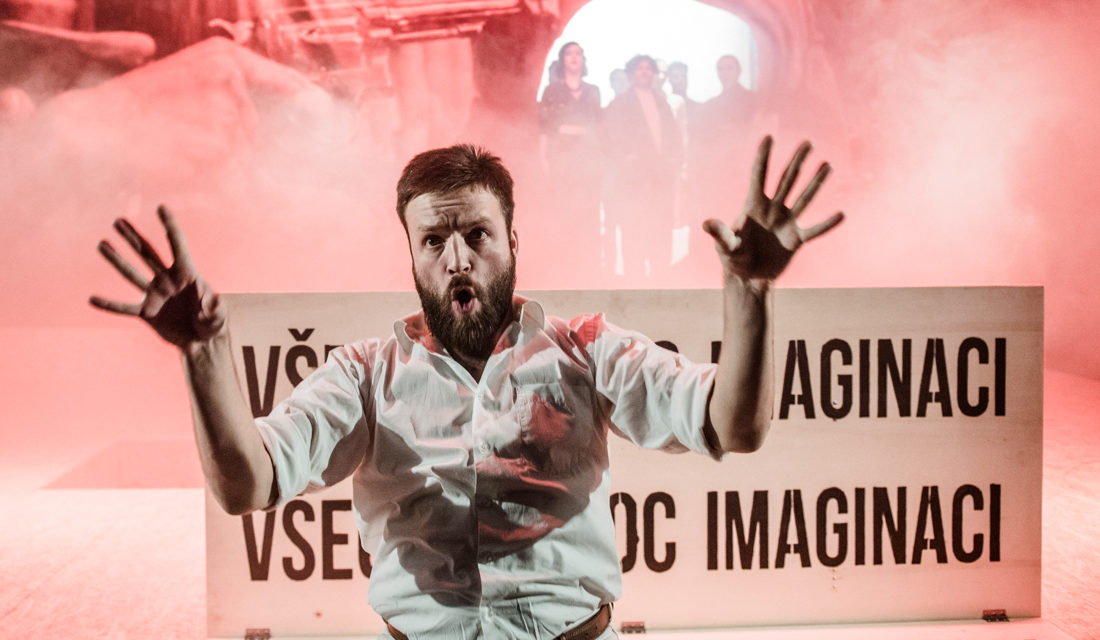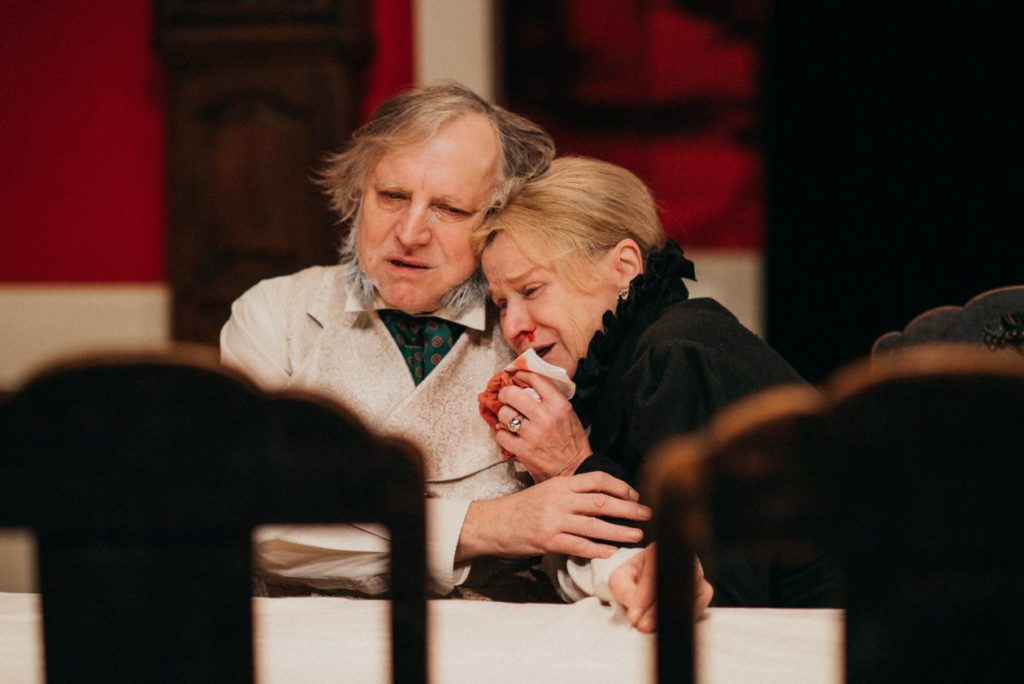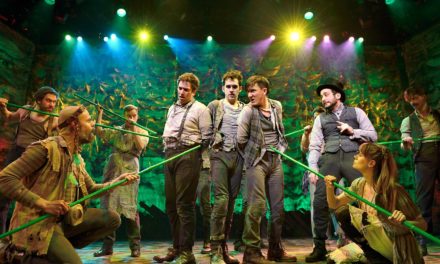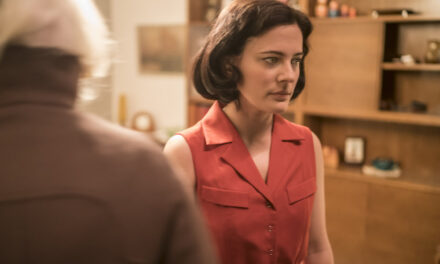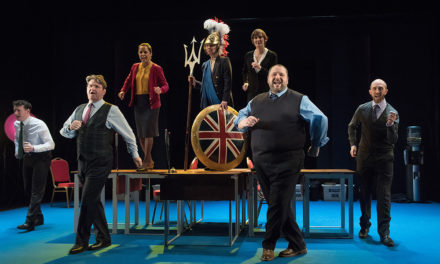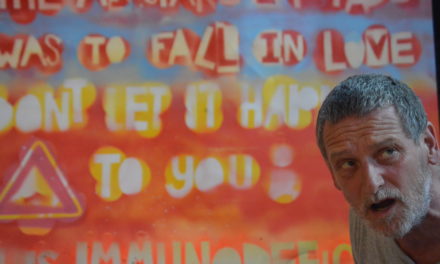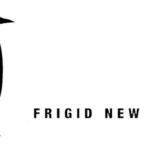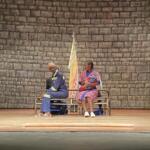For the first article about Czech theatre, I’ve selected works by two young directors, who belong between the most valued in their generation. Their names are Ivan Buraj and Michal Hába. They are both 30-ish, they both have recognizable and distinctive directing style. They both politically stand on the left and both of them are art directors of theatre companies.
Hába leads independent Prague group called Lachende Bestien (Laughing Beasts). This unkind nickname was given to the Czech nation by Reinhard Heydrich, acting Reich Protector of Bohemia and Moravia during WWII. Then Czech writer Bohumil Hrabal popularized it and it is more or less ironically (over)used till now. I’m not familiar with the genesis of naming the group but based on their works I guess it’s partly a provocation, especially because they use it in German. For the most part, they try to open a dialogue with this supposed national quality. They challenge it, but they also use it as an open pass for irony, dark humor and Brecht-inspired playfulness.
Buraj leads regular, which in the Czech Republic means repertoire, theater, that also has a long experimental tradition. It‘s called HaDivadlo, short for Hanácké theater. It resides in Brno (second largest Czech city) and it inhabits basement black box theatre space. Since its foundation, HaDivadlo functioned as an alternative to classical big scenes on every level, especially until the Velvet Revolution in 1989.
An attempt at The Petty Bourgeois as an environmental statement
It wasn’t much of a surprise, that HaDivadlo chose Maxim Gorky’s The Petty Bourgeois for the first premiere of the season. Gorky’s world view coincide with theirs. He also makes an unusual dramaturgical choice nowadays. He was hugely promoted by the communist regime, so there is still a slight aversion towards him. The big question however was, what will they make of him for today’s audience. And I have to say that the result is not satisfying.
Sets are a realistic replica of a bourgeois salon at the dawn of the 20th century. The main color is red and there is a lot of period furniture. Several entrances insinuate quite a big household. Nevertheless, the atmosphere of this place is older. Time stopped here in first half of the 19th century and it would make Brontë‘s sisters proud. Everything is dim, voices are very quiet on many occasions. Something in the overall silence speaks about a constant fear in the house. On the other hand, all is also slow and kind of lazy here.
The audience is confronted with the whole unhappy family. Despotic father with his demands and verbally violent behavior suffocates his wife, his children, and even the servants. Children are unable to leave due to lack of money, work and, of course, due to lack of will and ability to make decisions. The only one making something of himself is adopted son Nil (Mark Kristián Hochman). He works manually and he is preparing to leave the house. But he is also pushy towards young maid, he would like to marry. Servants obey and house guests just hedonically party all the time without caring about anybody else. All that considered there is no character arousing many sympathies.
A lacking craft of the art
One would expect creators to build some kind of a social statement out of this. It could have been commentary about the so-called traditional family or about omnipresent violence in relationships. Director Buraj and dramaturg Matěj Nytra chose to make it about something completely different, which is the main problem of the performance. Without any notice, they just let the performance end prematurely at the heat of the ongoing conflict. Actors start to undo their makeup and hair, to smoke or to play with their cellphones. The stage silences for a while and then a couple of subtitles are projected. They say, that meanwhile, the family drama was happening, our planet is not so slowly dying and we have 12 years to make a serious change.
It may read like a cool and radical concept, but it doesn’t feel like that in given surroundings. It feels like creators weren’t sure how to work this thought into performance, so they’ve just left it hanging without any building up to it.
However, there are also two memorable things besides the chilling atmosphere. The first is an interlarding of the story with images of characters‘ inner motions or significant props in the last but one scene. Dark interrupts the dialogue and after that mother is walking alone towards the window or there is a cone of sugar on the table. Then it gets dark again and the group scene is back.
Precise Stanislavski-based acting
The second and more important thing is acting. The whole ensemble acts in Stanislavski-based style and they do it precisely. There is a certainty that they can do it flawlessly and intensively, since the previous performance of Russian text, concretely Uncle Vanya (2016). But in cases of Cyril Drozda and Simona Peková (playing father and mother), these are one of the best executions in several years. Peková, usually strong, extrovert/extravagant and elegant, transforms into a submissive, quiet and introverted broken woman. She does it by losing expressive mimics, by silencing her voice and by keeping her body in the apparently very fragile state.
Drozda, on the other hand, is quite the psychological opposite. He also doesn’t have a wide variety of gestures or facial expressions. He mostly bashes the table with a fist. His voice is very pressing and he pronounces lento even when he shouts. That is enough to make him menacing and to leave no doubt of why the whole household is afraid of him.
The Gambler weighing capitalism
Buraj likes to dance around the main topic of the performance. Michal Hába usually tells right away, what his main goal is. Then he uses the performance to explore the subject further. His Gambler in Brno’s Goose on a String theater is no exception.
Although Hába leads his own group he has been invited to direct in several other theatres in the last year. Luckily for residents of Brno, Goose on a String was one of them. “Goose” has gotten its name from the title of a play by Czech modernist author Jiří Mahen. Goose also has a similar history as HaDivadlo, but it is older. Nowadays both ensembles are officially joined under one organization called Centre for Experimental Theatre.
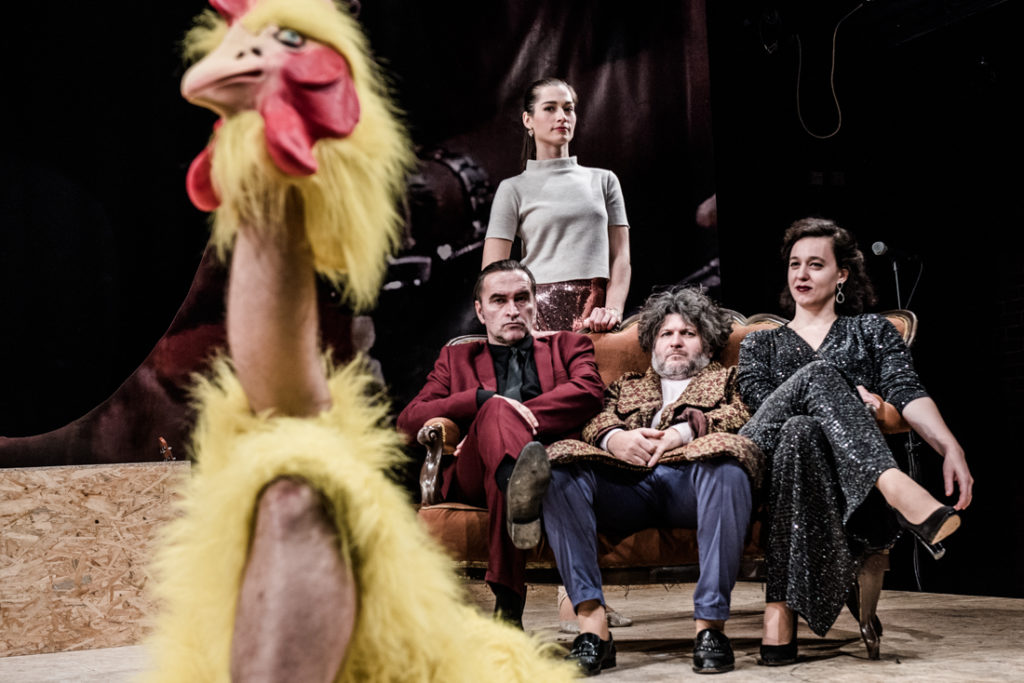
The Gambler at Goose on a String. S. Zmrzlá, J. Kolařík, T. Milostný, R. Dvořáková, D. Buš. Photo by Ivo Dvořák.
The Gambler without Dostoevsky
There is nothing much left of original Dostoevsky‘s novella in the performance. Hába pulls out only the most basic things: the main characters, the love affairs, a few crucial scenes. Above all that he presents the topic of gambling in the broadest sense imaginable. Money and its constant accumulation are shown as a gateway towards always wanting more; always wanting something newer, shinier and unknown in everyday life. The thrill feels fantastic, but it can’t be sustained, so the consequences are devastating. That’s nothing new under the sun, but Hába’s performance delivers this message in a very intriguing form.
There are two elements causing that. First one, deserving every appreciation, is the main actor Dalibor Buš. He and his acting abilities define the whole performance. He’s always on a stage and he is always moving. He is jumping into and out of his role, he is vividly communicating with the audience and he spends considerable time naked. He’s amazing in funny, light parts, especially when he is trying to provoke the audience to some action. Nevertheless, his performance wouldn’t be half as good without the last hard part when his character loses everything. He is exploding at the beginning, he is imploding in the end. Even if the music is still playing, he carries an aura of silence. His world is broken. His heart and body shut down, only his brain is working and it is still counting and weighing.
The flashy climax
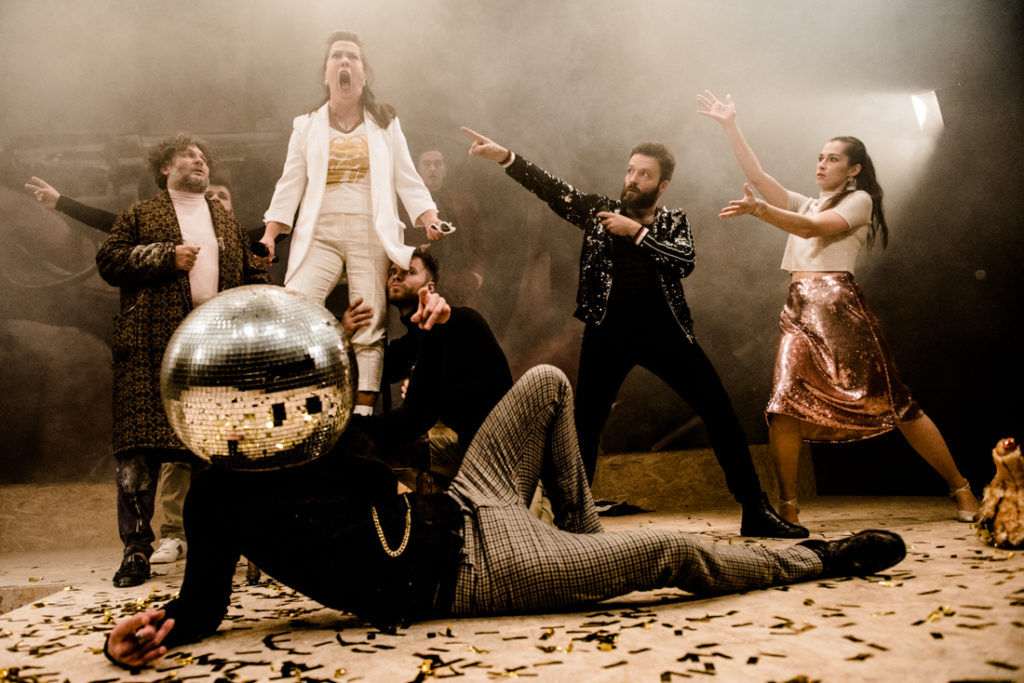
The Gambler at Goose on a String. T. Milostný, I. Hloužková, D. Buš, S. Zmrzlá, M. Holenda. Photo by Ivo Dvořák.
The second element is a treatment of the material with already mentioned Brecht-inspired playfulness. Same as Buš the whole performance is jumping. It switches from one timeline to another and from Dostoevsky to semi-improvised talks about today’s world. The climax of the swift tempo and of the first part is definitely the casino scene. Grandma (Ivana Hloužková), a holder of inheritance craved by every character, arrives healthy as a horse. She is also sharp as a knife and starts to gamble away all the money. She sits in a throne-like chair, has two male strippers at her side and she bets on zero multiple times.
Purple lighting and eventually flashy confetti cover the stage. Simple beat music and wonderful voices of two actresses Růžena Dvořáková and Simona Zmrzlá fill the space. The atmosphere gradates to prolonged happiness, which is getting emptier with every repetition of the bet. Then Grandma loses and the dark possibility of finality strikes with mighty power. Desire defeats love and honesty. Everyone gets their share of a bitter ending, but they are still walking the same paths.
I think that Hába’s work has a special feature. It is much easier to remember feelings, moments and images than thoughts presented in the performances. It is not due to a lack of them. Hába can simply make theatre theatrical again. He shows that sharing present moment is a very powerful thing. It gives the opportunity to affect the audience on a deeper level than the brain represents. Ability to do that through distancing effect and mainly epic acting creates wonderful tension holding his pieces together.
This post was written by the author in their personal capacity.The opinions expressed in this article are the author’s own and do not reflect the view of The Theatre Times, their staff or collaborators.
This post was written by Jiřina Hofmanová.
The views expressed here belong to the author and do not necessarily reflect our views and opinions.

